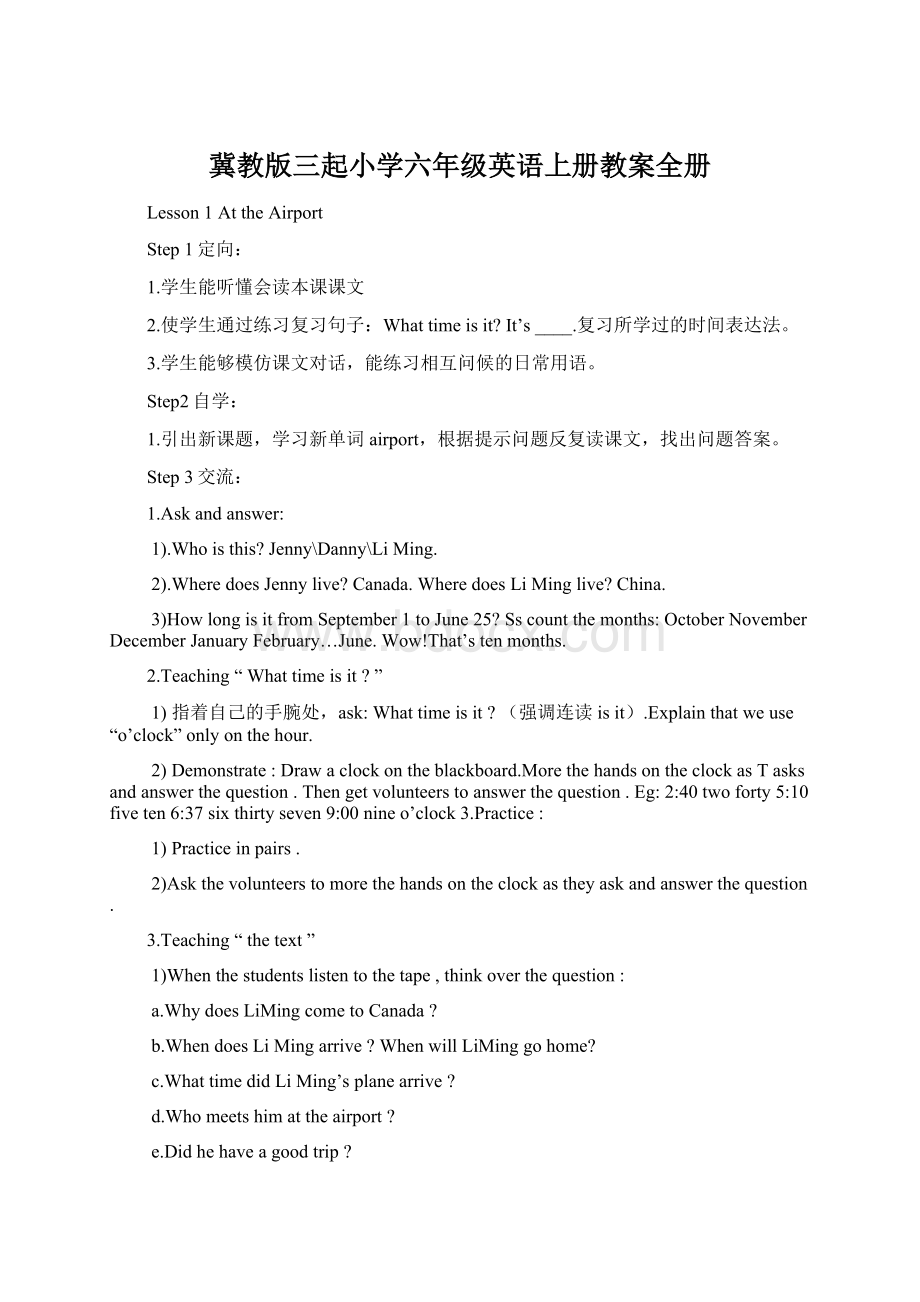冀教版三起小学六年级英语上册教案全册文档格式.docx
《冀教版三起小学六年级英语上册教案全册文档格式.docx》由会员分享,可在线阅读,更多相关《冀教版三起小学六年级英语上册教案全册文档格式.docx(29页珍藏版)》请在冰豆网上搜索。

Whattimeisit?
(强调连读isit).Explainthatweuse“o’clock”onlyonthehour.
2)Demonstrate:
Drawaclockontheblackboard.MorethehandsontheclockasTasksandanswerthequestion.Thengetvolunteerstoanswerthequestion.Eg:
2:
40twoforty5:
10fiveten6:
37sixthirtyseven9:
00nineo’clock3.Practice:
1)Practiceinpairs.
2)Askthevolunteerstomorethehandsontheclockastheyaskandanswerthequestion.
3.Teaching“thetext”
1)Whenthestudentslistentothetape,thinkoverthequestion:
a.WhydoesLiMingcometoCanada?
b.WhendoesLiMingarrive?
WhenwillLiMinggohome?
c.WhattimedidLiMing’splanearrive?
d.Whomeetshimattheairport?
e.Didhehaveagoodtrip?
2)Readthedialogueanddiscussthequestionsingroups.
3)Askthestudentstoanswerthequestions.
Step4答疑:
针对错误问题重点讲解!
Step5检测:
Makeupadialogueaboutmeetingsomeoneattheairport.Use“Whattimeisit?
It’s.”
板书:
Lesson1AttheAirport
5o’clock——Whattimeisit?
6o’clock——It’s5:
25.
教学反思:
Lesson2Jenny’sHouse
1、能听、说、读、写单词:
bedroom;
kitchen;
bathroom;
livingroom,toilet,study
2、能用英语简单描述自己的家中的各个房间。
3、能正确运用Therebe….和Hereis…..句式。
本课所认识的单词和新句式。
1.Greetings
2.Revision
Usevocabularycardstoreviewthewords“house”,“classroom”,“bathroom”,“bed”.
3.Keyconcepts:
room,kitchen,bathroom,livingroom1.
Introduce:
a.Usepostersofroomstodemonstrateeachword.
b.Pointouttheword“room”inbathroom,bedroomandlivingroom.
c.Freetalk
4.Studentbook:
Playtheaudiotapeasthestudentsfollowintheirbooks
1).Teach“Therebe”句式.UsearoomtointroducesomeobjectssayThereisa….Thereare……s.
2).Sssaysentencesfreely,theyshouldintroducesomeobjectssayThereisa….Thereare……s.
Useapicture-promptdrill.Holdupvocabularycardsforobjectsfoundinparticularroom.Dividetheclassintosmallgroups.Askeachgrouptomakeupadialogueaboutshowingsomeonearoundanewhouse.
ConsolidationFilltheblanks.Askonevolunteertoshow.
Tellthestudentstolookatthepicturesoftheroomtohelpthemcompletethe4sentencesinPart2.ThedrawtheirhomesandwritewithThereisa…Thereare…
Step
Writesomesentencestodescribeyourroomsinyourhouse.
板书:
Lesson2Jenny’sHouse
bedroomkitchenbathroomlivingroom,toilet,study
Thereisatoilet.Hereisthebathroom.
Therearesomefourbedrooms.
:
//www.xkb1.comLesson3:
MakingBreakfast
1.使学生争取掌握(正确地说、读、写、用)单词:
make,breakfast,tableputhalf
2.学生能够理解并且掌握句型:
Whatwouldyoulikeforbreakfast?
Iwouldlikea/an/some____,please.
本课所认识的单词和新句型。
1.Greetings.
2.Review:
1)Play“Whattimeisit?
“toreviewthewaytosaysometimes.
2)Play“Drawandguess”toreviewthewordsoffood.
Presentation
1.Teach“makeandcook”(Explain“cook”)Askthestudentstocometothefronttowritetheanswer.
S1:
Iwanttocook___.S2:
Iwanttomake___.
2.Teachthenewwords“breakfast,tableputhalf”
1)Play“Simonsays“topracticethenewwords.
2)Askthestudentstocometothefronttoread.
DrillandPractice
1.Studythedialogue
2.Openyourbooks,readthepartoneandanswermyquestion.WhatwouldJennyandLiMinglikeforbreakfast?
3.Listentothetapeandfillintheblank.
1)Mumis_________eggsinthe_________.
2)Thejuiceisinthe_____________.
3)Let’sputthe_________onthe_________.
Dividetheclassintosmallgroups.Askeachgrouptomakeupadialogueaboutmakingamealinakitchen.
Step4.StudentsfillintheblanksinPart2-1.Thenmakeadialoguewiththewordsandwouldlike….
Readthepassageinpart2-2tothestudents.Tellstudentstotickthecorrectreponsesbelowthatgowiththepassage.Checkasaclass.
1.Makeadialogue.
2.writeashortdialogueorpassageaboutamealinakitchen.
板书设计:
Lesson3:
MakingBreakfast
Whatwouldyoulikeforbreakfast?
Iwouldlikea,an___,please.
dish-----dishesrefrige
Iwouldlikesome___,please.
Lesson4:
MakingDinner
1.知识目标:
要求学生掌握四会单词:
lunch/clean/dirty/dinner/dry.
2.能力目标:
理解并能够运用本课所学内容进行日常的会话练习。
3.情感目标:
培养学生热爱劳动的思想感情。
本课所认识的单词,日常会话练习。
(一)、Classopeningandreview
1、Greeting.
2、Review:
Playavariationof“Whereistheworld?
”toreviewroomsandobjectsthatgointhem.
3、Sing“IntheBathroom.”
(二)、Keyconcepts:
1.Introduce:
Demonstratethenewvocabularywithabasinofwater,somedishdetergent,somerealdishesandatowel.Washanddrythedishesandsay:
Thesearedishes.Thesedishesaredirty.Let’swashthedishesinthesink.Now,Iamwashingthedishes.
2.Usethestudentbookandaudiotape.PausebetweenNumber1andNumber2.WhatwillLiMingdoafterJennysays“Pleasepassmethepeas”?
Practice:
Dividethatclassintosmallgroups.Askeachgrouptomakeupadialogueaboutcleananddirty.Encouragethestudentstohavefun.Whatgetsdirty?
How?
Where?
Playagamesuchas“Gofish”or“Memorycards”.Play“opposites”andincludethenewvocabulary.
Usetheactivitybook.Number1isalisteningexerciseontheaudiotape.
Checkforunderstanding.
Tellstudentsmatcheachsentencetocorrectpictureabovebyputtingthenumberofthepictureinthesquaretotheleftofthesentence..Thencompleteeachsentencebyfillingintheblanksspaces.Checkasaclass.
Lesson4:
lunchdinnerdish(dishes)cleandrydirty
Lesson5:
Inthelivingroom
1、知识与技能目标
(1)听、说、读、写单词me,him,them,card,Mr.Mrs.
(2)能够牢固掌握现在进行时,并将之灵活运用到课文图片的谈论及实际生活中,就家人在家里的活动用现在进行时进行简单、准确的描述。
2、情感及文化目标
(1)激发学生听英语、说英语、用英语和他人进行交流的兴趣,敢于用英语进行表达,并能主动利用语言环境大胆实践。
(2)鼓励学生根据所学知识谈论自己家客厅的物品及家人,使之能在小组活动中积极参与他人合作,互相帮助,增强学生的团结合作意识。
(3)通过学习客厅物品及能家人的描述,教育学生珍惜亲情,热爱家庭,增强学生对家的热爱及对父母的尊重。
(1)学习单词me,him,them,card,Mr.Mrs.
(2)掌握动词短语。
如:
watchTV,readthenewspaper,playcards,writealetter,sitinthechair,
(3)现在进行时的理解、掌握和运用。
1:
warmingup
A.singasong“Inthelivingroom”
B.revision
2:
newteaching
出示Jenny家客厅的图片课件Whatcanyoufindinthelivingroom?
Whatdoyoudointhelivingroom?
3.game教师让一个学生看动词短语,然后做动作,其他同学回答:
whatishe\shedoing?
whatareyou\theydoing?
\whatamIdoing?
教师把黑板上的短语变成现在进行时的句子。
出示现在进行时自我介绍的picture,askandansweraboutthepicture.出示Jenny家客厅的图片
listentothetapeandanswerthequestion“Iseveryoneinthelivingroomquiet?
”Listen,repeatandcheckyouranswers.
activities.Showapictureofyourlivingroomandtalkaboutitwithyourpartner.
Tellthestudentstofillinblankineachofthesentencesbywritinginthecorrectpronounfromtheyellowboxontherightsideofthesentence.
Studentsshouldlistentoeachofthefollowingsentencesandrepeatthem.Tellthestudentstoputtheinflectionsandstressesintherightplaceineachofthesentencesasnotebytheredmarkingsineachofthefoursentences.
Homework:
Talkaboutyourlivingroomwithyourfriendsandyourfamily.
Lesson5:
Inthelivingroom
me,him,them,card,Mr.Mrs.
watchTVreadthenewspaperplaycardswritealettersitinthechair
教学反思:
Lesson6:
BabyBeckyatHome
知识目标;
学生听懂并理解这个简单的故事。
能力目标:
能看懂故事,提高阅读能力。
情感目标:
渗透劳动意识,培养劳动习惯。
自读课文理解这个故事。
1.Greeting
2.Review
Usethequizinthestudentbookasreview.Observethestudentsclosely.
3.StoryUsethestorybookandaudiotape.PreparetoReadHerearesomequestionsIcanusetopreparethestudentsforthestory.UseasmuchEnglishaspossible,butallowthediscussiontotakeplaceinChinesewherenecessary.WhoremembersBabyBecky?
WhatisBabyBeckydoinginthisstory?
......Read可以利用录音带和故事书,让学生边听边阅读,阅读完毕能从故事中找出本单元的重点单词,并通过Findthewords.等形式,训练学生熟练拼写单词。
wWw.Xkb1.cOm
HerearesomequestionsIcanusetoreinforcethemainideaofthestory.WhatdoesBabyBeckydoathome?
DoesBabyBecky“help”hermother?
DidBabyBeckyhavefun?
Didhermotherhavefun?
Whynot?
WheredoesBabyBecky“help”hermothercook?
HowdoesBabyBeckygetdirty?
WheredoeshermothertakeBabyBeckywhensheisdirty?
Doyoulikethisstory?
Whyorwhynot?
……
完成课后问题
Lesson6:
1.Arethesedishescleanordirty?
Thedishesareclean.
2.WhatisMr.Smithdoing?
Mr.Smithiswashingthedishesinthesink.
3..Where’sthetoilet?
Thetoiletisinthebathroom.
4.WhatdoesBabyBeckydoathome?
5.DoesBabyBecky“help”hermother?
Lesson7:
OntheSchoolBus
1.学习并掌握always,sometimes,often,never等表示频度的词汇。
2.掌握四会词汇:
dry/wet,umbrella能力目标:
学生能用所学词汇、句型谈论日常生活的一些话题。
本课所认单词,理解和运用alwaysoftensometimesnever
1.问候
2.复习常用短语:
(eatbreakfastwatchTVgotothepark,gotoschoolbybus…可以出示卡片,进行复习)
3.KeyConcepts
(1)Always/usually/sometimes/never的教学。
(2)单词的理解和运用。
(由于这四个表示频度的副词对学生来说比较抽象,所以教师可以利用上面的图示帮助学生认读并熟记单词,有必要让学生说说这四个单词的区别,从而让他们理解并能灵活运用。
)(设计意图:
通过这个环节的设置可以形象、直观地让学生明白这四个单词的意思)
(3)巩固操练。
教师给每个学生一张表格(如:
下图),教师描述表格中每个人所做的事情,让学生完成表格。
namedohomeworkWatchTVWalktoschoolWeardressesJennyStevenDanny(设计意图:
在这个练习的过程中,既是学生听力的训练,又是进一步熟记